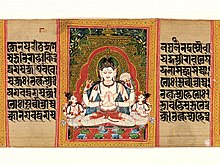Gouache


Gouache(/ɡuˈɑːʃ,ɡwɑːʃ/;French:[ɡwaʃ]),body color,[a]oropaque watercoloris a water-medium paint consisting ofnatural pigment,water, a binding agent (usuallygum arabicordextrin),[1]and sometimes additionalinert material.Gouache is designed to beopaque.Gouache has a long history, having been used for at least twelve centuries. It is used most consistently bycommercial artistsfor posters, illustrations,comics,and other design work.
Gouache is similar towatercolorin that it can be rewetted and dried to a matte finish, and the paint can become infused into its paper support. It is similar toacrylicoroil paintsin that it is normally used in an opaque painting style and it can form a superficial layer. Many manufacturers of watercolor paints also produce gouache, and the two can easily be used together.
Description
[edit]Gouache paint is similar towatercolor,but it is modified to make itopaque.Just as in watercolor, the binding agent has traditionally beengum arabicbut since the late nineteenth century cheaper varieties useyellow dextrin.When the paint is sold as a paste, e.g. in tubes, the dextrin has usually been mixed with an equal volume of water.[1]To improve the adhesive andhygroscopicqualities of the paint, as well as the flexibility of the rather brittle paint layer after drying,propylene glycolis often added.[1]Gouache differs from watercolor in that the particles are typically larger, the ratio of pigment to binder is much higher, and an additional white filler such as chalk—a "body" —may be part of the paint. This makes gouache heavier and more opaque than watercolor, and endows it with greater reflective qualities.[2]
Gouache generally dries to avaluethat differs from the one it has when wet (lighter tones generally dry darker and darker tones tend to dry lighter), which can make it difficult to match colors over multiple painting sessions. Its quick coverage and totalhiding powermean that gouache lends itself to moredirect paintingtechniques than watercolor.[3]"En plein air"paintings take advantage of this, as do the works ofJ. M. W. Turner.
Gouache is today much used by commercial artists for works such as posters, illustrations, comics, and for other design work. Most 20th-centuryanimationsused it to create an opaque color on acelwith watercolor paint used for the backgrounds. Using gouache as "poster paint"is desirable for its speed as the paint layer dries completely by the relatively quick evaporation of the water.
The use of gouache is not restricted to the basic opaque painting techniques using a brush andwatercolor paper.It is often applied with anairbrush.As with all types of paint, gouache has been used on unusual surfaces from Braille paper[4]tocardboard.A variation of traditional application is the method used in thegouachesdécoupées(cut collages) created byHenri Matisse.HisBlue Nudesseries is a good example of the technique. A new variation in the formula of the paint isacrylic gouache.
History
[edit]
A form of gouache, with honey ortragacanthgum as a binder, was used inAncient Egyptian painting.It was also used in Europeanilluminated manuscripts,[5]as well asPersian miniatures.Although they are often described as "watercolor", Persian miniatures andMughal miniaturesare predominantly examples of gouache.[6]The term gouache, derived from the Italianguazzo,also refers to paintings using this opaque method. "Guazzo", Italian for "mud", was originally a term applied to the early 16th-century practice of applyingoil paintover atemperabase,[7]which could give a matted effect. In the 18th century inFrance,the termgouachewas applied to opaque watermedia.
During the eighteenth century gouache was often used in a mixed technique, for adding fine details inpastelpaintings. Gouache was typically made by mi xing watercolours based on gum arabic with an opaque white pigment. In the nineteenth century, watercolours began to be industrially produced in tubes and a "Chinese white"tube was added to boxes for this purpose. Gouache tends to be used in conjunction with watercolor, and often ink or pencil, in 19th-century paintings.
Later that century, for decorative uses "poster paint" (as it is known in the U.S.), was mass-produced, based on the much cheaper dextrin binder. It was sold in cans or as a powder to be mixed with water. The dextrin replaced older paint types based onhide glueorsize.During the twentieth century, gouache began to be specially manufactured in tubes for more refined artistic purposes. Initially, gum arabic was used as a binder but soon cheaper brands were based on dextrin, as is most paint for children.
-
Asphodelus ramosusby Hans Simon Holtzbecker, 1649–1659, gouache onparchment,50.5 cm × 38.5 cm (20 in ×15+1⁄4in)
-
Exeterand the Canal BasinbyJohn Gendallbetween 1835 and 1840; watercolour and gouache on paper
-
Honoré Daumier,Une cause célèbre,ca.1862
-
Claude Monet,Sunset at Sea,1865–70,Ashmolean Museum,Oxford
-
Josep Maria Tamburini,Young Girl with a Hat,1909,38 cm × 25 cm (15 in ×9+3⁄4in)
-
Léon Bénigni, cover design forFeminamagazine, 1920s
-
Roman Nyman, stage design for a drama, 1923.Tartu Art Museum,Estonia
Acrylic gouache
[edit]A relatively new variation in the formula of the paint isacrylic gouache.Its highly concentrated pigment is similar to traditional gouache, but it is mixed with an acrylic-based binder, unlike traditional gouache, which is mixed with gum arabic. It is water-soluble when wet and dries to a matte, opaque, and water-resistant surface when dry. Acrylic gouache differs fromacrylic paintbecause it contains additives to ensure the matte finish.[8]
See also
[edit]Notes
[edit]- ^The alternative term "body color" is sometimes one word "bodycolor".
References
[edit]- ^abcDoerner, Max (1977).Schilderkunst — materiaal en techniek.Amerongen: Gaade. p. 113.ISBN9060178289.
- ^Cohn, Marjorie (1977).Wash and Gouache.Cambridge: Center for Conservation and Technical Studies, Fogg Art Museum.ISBN0916724069.
- ^Dehn, Adolf (1955).Water Color, Gouache, and Casein Painting.New York: Studio.OCLC1192031.
- ^Vienna Parreno has painted on Braille paper."Beyond Retinal Titillation: Seeing Red: Blog: Vienna Parreno".Archived fromthe originalon 2008-08-01.Retrieved2008-07-23.
- ^Osborne, Harold (ed),The Oxford Companion to Art,p. 496, 1970, OUP,ISBN019866107X
- ^"The Minassian Collection of Persian, Mughal, and Indian Miniature Paintings".library.brown.edu.Retrieved2020-08-10.
- ^Mayer, Ralph.The Artist's Handbook of Materials and Techniques,Viking Adult; 5th revised and updated edition, 1991.ISBN0-670-83701-6
- ^Buchman, Bill (2010).Expressive Figure Drawing: New Materials, Concepts, and Techniques.New York: Watson-Guptill Publications. p. 50.ISBN9780823033140.
Sources
[edit]- "Bodycolor", thedrawingsite, 2009, web:TDS-bodycolor(archived 2012-02-27).
- Gouache at MSN Encarta-8754archived 2009-10-28
External links
[edit]- Gouache from the Tate
- Demo of technique
- Info & history
- .Encyclopædia Britannica(11th ed.). 1911.








